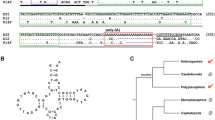Abstract
Analyses of the 5S rRNA genes found in the spliced-leader (SL) gene repeat units of numerous trypanosome species suggest that such linkages were not inherited from a common ancestor, but were the result of independent 5S rRNA gene insertions. In trypanosomes, 5S rRNA genes are found either in the tandemly repeated units coding for SL genes or in independent tandemly repeated units. Given that trypanosome species where 5S rRNA genes are within the tandemly repeated units coding for SL genes are phylogenetically related, one might hypothesize that this arrangement is the result of an ancestral insertion of 5S rRNA genes into the tandemly repeated SL gene family of trypanosomes. Here, we use the types of 5S rRNA genes found associated with SL genes, the flanking regions of the inserted 5S rRNA genes and the position of these insertions to show that most of the 5S rRNA genes found within SL gene repeat units of trypanosome species were not acquired from a common ancestor but are the results of independent insertions. These multiple 5S rRNA genes insertion events in trypanosomes are likely the result of frequent founder events in different hosts and/or geographical locations in species having short generation times.





Similar content being viewed by others
References
Aksoy S, Williams S, Chang S, Richards FF (1990) SLACS retrotransposon from Trypanosoma brucei gambiense is similar to mammalian LINEs. Nucleic Acids Res 18:785–792
Altschul SF, Madden TL, Schäffer AA, Zhang J, Zhang Z, Miller W, Lipman DJ (1997) Gapped BLAST and PSI-BLAST: a new generation of protein database search programs. Nucleic Acids Res 25:3389–3402
Arnheim N (1983) Concerted evolution of multigene families. In: Nei M, Koehn RK (eds) Evolution of genes and proteins. Sinauer, Sunderland, pp 38–61
Baldauf S (2008) An overview of the phylogeny and diversity of eukaryotes. J Syst Evol 46:263–273
Bedard JE, Schurko AM, de Cock AW, Klassen GR (2006) Diversity and evolution of 5S rRNA gene family organization in Pythium. Mycol Res 110:86–95
Berriman M, Ghedin E, Hertz-Fowler C et al (2005) The genome of the African trypanosome Trypanosoma brucei. Science 309:416–422
D’Avila-Levy CM, Volotão AC, Araújo FM, de Jesus JB, Motta MC, Vermelho AB, Santos AL, Branquinha MH (2009) Bodo sp., a free-living flagellate, expresses divergent proteolytic activities from the closely related parasitic trypanosomatids. J Eukaryot Microbiol 56:454–458
Deschamps P, Lara E, Marande W, Lòpez-García P, Ekelund F, Moreira D (2011) Phylogenomic analysis of kinetoplastids supports that trypanosomatids arose from within bodonids. Mol Biol Evol 28:53–58
Dover GA (1982) Molecular drive: a cohesive mode of species evolution. Nature 299:111–117
Drouin G (2000) Expressed retrotransposed 5S rRNA genes in the mouse and rat genomes. Genome 43:213–215
Drouin G, Moniz de Sà M (1995) The concerted evolution of 5S ribosomal genes linked to the repeat units of other multigene families. J Mol Evol 12:481–493
Drouin G, Tsang C (2012) 5S rRNA gene arrangements in protists: a case of nonadaptive evolution. J Mol Evol 74:342–351
El-Sayed NM, Myler PJ, Bartholomeu DC et al (2005) The genome sequence of Trypanosoma cruzi, etiologic agent of Chagas disease. Science 309:409–415
Hamilton PB, Stevens JR, Gaunt MW, Gidley J, Gibson WC (2004) Trypanosomes are monophyletic: evidence from genes for glyceraldehyde phosphate dehydrogenase and small subunit ribosomal RNA. Int J Parasitol 34:1393–1404
Hamilton PB, Teixeira MMG, Stevens JR (2012) The evolution of Trypanosoma cruzi: the ‘bat seeding’ hypothesis. Trends Parasitol 28:136–141
Hughes AL, Piontkivska H (2003a) Phylogeny of Trypanosomatidae and Bodonidae (Kinetoplastida) based on 18S rRNA: evidence for paraphyly of Trypanosoma and six other genera. Mol Biol Evol 20:644–652
Hughes AL, Piontkivska H (2003b) Molecular phylogenetics of Trypanosomatidae: contrasting results from 18S rRNA and protein phylogenies. Kinetoplastid Biol Dist 28:15
Jackson AP, Berry A, Aslett M, Allison HC, Burton P, Vavrova-Anderson J, Brown R, Browne H, Corton N, Hauser H, Gamble J, Gilderthorp R, Marcello L, McQuillan J, Otto TD, Quail MA, Sanders MJ, van Tonder A, Ginger ML, Field MC, Barry JD, Hertz-Fowler C, Berriman M (2012) Antigenic diversity is generated by distinct evolutionary mechanisms in African trypanosome species. Proc Natl Acad Sci USA 109:3416–3421
Noireau F, Diosque P, Jansen AM (2009) Trypanosoma cruzi: adaptation to its vectors and its hosts. Vet Res 40:26
Rodrigues AC, Garcia HA, Batista JS, Minervino AH, Goes-Cavalcante G, Maia da Silva F, Ferreira RC, Campaner M, Paiva F, Teixeira MM (2010) Characterization of spliced leader genes of Trypanosoma (Megatrypanum) theileri: phylogeographical analysis of Brazilian isolates from cattle supports spatial clustering of genotypes and parity with ribosomal markers. Parasitology 137:111–122
Stevens JR, Noyes HA, Dover GA, Gibson WC (1999a) The ancient and divergent origins of the human pathogenic trypanosomes, Trypanosoma brucei and T. cruzi. Parasitology 118:107–116
Stevens JR, Teixeira MM, Bingle LE, Gibson WC (1999b) The taxonomic position and evolutionary relationships of Trypanosoma rangeli. Int J Parasitol 29:749–757
Torres-Machorro AL, Hernández R, Cevallos AM, López-Villaseñor I (2010) Ribosomal RNA genes in eukaryotic microorganisms: witnesses of phylogeny? FEMS Microbiol Rev 34:59–86
Wicke S, Costa A, Muñoz J, Quandt D (2011) Restless 5S: the re-arrangement(s) and evolution of the nuclear ribosomal DNA in land plants. Mol Phylogenet Evol 61:321–332
Zhang H, Campbell DA, Sturm NR, Lin S (2009) Dinoflagellate spliced leader RNA genes display a variety of sequences and genomic arrangements. Mol Biol Evol 26:1757–1771
Acknowledgments
We would like to thank the Wellcome Trust Sanger Institute for providing free public access to the full genomes of T. brucei, T. congolense, T. cruzi and T. vivax. We also thank Drs. Stéphane Aris-Brosou and David Currie (Biology Department, University of Ottawa), as well as the two anonymous referees, for their constructive comments and suggestions. This work was supported by a discovery grant from the Natural Science and Engineering Research Council of Canada to G. D.
Author information
Authors and Affiliations
Corresponding author
Additional information
Communicated by S. Hohmann.
Rights and permissions
About this article
Cite this article
Beauparlant, M.A., Drouin, G. Multiple independent insertions of 5S rRNA genes in the spliced-leader gene family of trypanosome species. Curr Genet 60, 17–24 (2014). https://doi.org/10.1007/s00294-013-0404-z
Received:
Revised:
Accepted:
Published:
Issue Date:
DOI: https://doi.org/10.1007/s00294-013-0404-z




